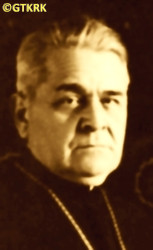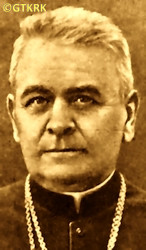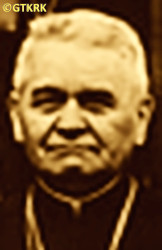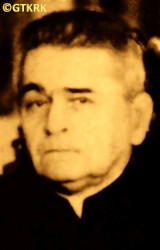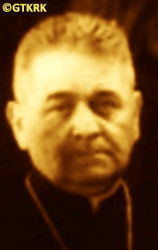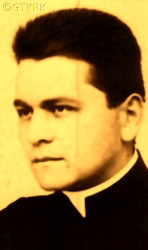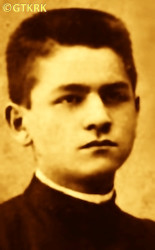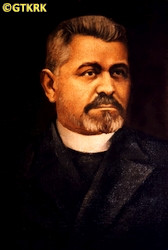Roman Catholic
St Sigismund parish
05-507 Słomczyn
85 Wiślana Str.
Konstancin deanery
Warsaw archdiocese, Poland
full list:
displayClick to display full list

searchClick to search full list by categories
wyświetlKliknij by wyświetlić pełną listę po polsku

szukajKliknij by przeszukać listę wg kategorii po polsku

Martyrology of the clergy — Poland
XX century (1914 – 1989)
personal data
surname
KOSTELNIK
surname
versions/aliases
KOSTELNYK
forename(s)
Gabriel

function
presbiter (i.e. iereus)
creed
Eastern Orthodox Church ORmore on
en.wikipedia.org
[access: 2014.09.21]
Ukrainian Greek Catholic GCmore on
en.wikipedia.org
[access: 2013.05.19]
diocese / province
Lviv‐Ternopil OR eparchymore on
ru.wikipedia.org
[access: 2023.08.19]
Lviv GC archeparchymore on
en.wikipedia.org
[access: 2013.05.19]
academic distinctions
Doctor of Philosophy
nationality
Ukrainian
date and place
of death
20.09.1948

Lvivtoday: Lviv urban hrom., Lviv rai., Lviv obl., Ukraine
more on
en.wikipedia.org
[access: 2022.01.16]
details of death
According to unconfirmed Russian sources, at the beginning of 1939, with the knowledge of the Metropolitan of the Lviv Eparchy, Abp Andrew Szeptycki, was to participate in discussions on the establishment of the „Ukrainian People's Church” and breaking with the Catholic Church.
After the German and Russian invasion of Poland in 09.1939 and the start of World War II, after the beginning of the Russian occupation, was being groomed — in connection with it seems the dogmatic conflict with Abp Szeptycki in c. 1929, concerning mainly the issue of celibacy reform in the Greek Catholic Church, which led to his dismissal from many prestigious functions in the archieparchy — by Russians for the anti‐Szeptycki stance (on 11.01.1941, the head of the NKVD, Lavrentiy Beria, approved a plan of action against the Greek Catholic Church; fiscal pressures and high taxes on Catholics were part of the plan). Allegedly refused, but after the arrest of his eldest son by the genocidal Russian NKVD organization, was to agree and wrote — according to the script prepared by the NKVD — a number of articles on breaking the union with Rome.
The practical implementation of the project was hindered by the German attack on 22.06.1941 on their erstwhile ally, the Russians, and the start of the German occupation.
After the German defeat, however, and the start of the Russian occupation of Lviv in 07.1944, the Russians returned to the original plan. Was arrested again by the NKVD — probably was blackmailed in connection with the service of his younger sons in the genocidal formations of the German Waffen‐SS, i.e. SS‐Galizien — and again agreed to cooperate with the Russians.
Then the NKVD arrested almost all Greek Catholic bishops, and on 30.05.1945 became the chairman of the Central Initiative Group for the Incorporation of the Greek Catholic Church into the Russian Orthodox Church, aimed at preparing the so‐called pseudo–ecumenical council of Lviv and announcing the apostasy of the Greek Catholic Church, breaking the union with Rome and joining the Orthodox Church. Chaired that council on 08–10.03.1946 in Lviv — joining the Moscow Orthodox Patriarchate was announced there (apparently 997 out of 1,270 Greek Catholic priests expressed support of the apostasy).
After the council prob. attempted to call a New Orthodox Church, independent of Moscow — i.a. against the Orthodox bishop Macarius Oksiyuk, but the NKVD did not allow it. In 1946‐1947, was allegedly protected by the MGB (NKVD successor) against death threats from the genocidal Ukrainian organization OUN/UPA.
Shot with two shots on Krakówska Street, near the Transfiguration Orthodox church (former Greek Catholic church where ministered in the past), in Lviv, when was returning home from the service. According to some sources, the perpetrator committed suicide on the spot.
Ukrainian and Russian sources have blamed each other — the Russians claim that the killer was a member of the OUN/UPA, while the Ukrainians say that the MGB. And the Moscow Patriarchate, in a statement signed by Metropolitan Nicholas Jaruszewicz, stated that „was murdered by Vatican agents”.
cause of death
murder
perpetrators
Russians / Ukrainians
sites and events
«Genocidium Atrox»Click to display the description, GeneralgouvernementClick to display the description, Ribbentrop‐MolotovClick to display the description, Pius XI's encyclicalsClick to display the description
date and place
of birth
15.06.1886

Ruski Krsturtoday: Kula mun., West Bačka dist., Vojvodina prov., Serbia
more on
en.wikipedia.org
[access: 2023.08.19]
presbyter (holy orders)
ordination
20.04.1913

positions held
1946 – 1948
presbiter (Eng. priest, i.e. iereus) — Lvivtoday: Lviv urban hrom., Lviv rai., Lviv obl., Ukraine
more on
en.wikipedia.org
[access: 2022.01.16] ⋄ Russian Orthodox Church — also: editor of the Orthodox Bulletin of the Orthodox Eparchy
04.1946
protopresbiter — Moscowtoday: Moscow city, Russia
more on
en.wikipedia.org
[access: 2020.07.31] ⋄ Russian Orthodox Church — dignity conferment
10.03.1946
apostasy — Lvivtoday: Lviv urban hrom., Lviv rai., Lviv obl., Ukraine
more on
en.wikipedia.org
[access: 2022.01.16] — conversion from Greek Catholic Church to Orthodox Church
c. 1913 – c. 1945
prefect — Lvivtoday: Lviv urban hrom., Lviv rai., Lviv obl., Ukraine
more on
en.wikipedia.org
[access: 2022.01.16] ⋄ secondary schools — teacher at the Ukrainian Academic Gymnasium /from 1933 Ukrainian Academic Gymnasium and Lyceum, during the Russian occupation of 1939‐1941 transformed into Secondary School No. 1 (c. 1921‐1945), John and Andrew Śniadecki's XI State Gymnasium and Lyceum (ca. 1936–1939), real schools (ca. 1913–1918); also: philosophy teacher
c. 1921 – c. 1941
judge — Lvivtoday: Lviv urban hrom., Lviv rai., Lviv obl., Ukraine
more on
en.wikipedia.org
[access: 2022.01.16] ⋄ 1st Instance, Archeparchy's Metropolitan Court ⋄ Lviv GC archeparchy
c. 1921 – c. 1945
curialist — Lvivtoday: Lviv urban hrom., Lviv rai., Lviv obl., Ukraine
more on
en.wikipedia.org
[access: 2022.01.16] ⋄ Archeparchial Consistory (i.e. Curia) — counselor (c. 1921‐1945), clerk (c. 1921‐1933), member (c. 1928‐1930) and deputy member (c. 1933, a. 1921‐1927) of the Management Committee for the Fund of Widows and Orphans of Priests of the Archeparchy of Lviv
c. 1931 – c. 1945
preacher — Lvivtoday: Lviv urban hrom., Lviv rai., Lviv obl., Ukraine
more on
en.wikipedia.org
[access: 2022.01.16] ⋄ St George GC archcathedral church — prob.
c. 1915 – c. 1933
vicar — Lvivtoday: Lviv urban hrom., Lviv rai., Lviv obl., Ukraine
more on
en.wikipedia.org
[access: 2022.01.16] ⋄ Transfiguration of the Lord GC parish ⋄ Lvivtoday: Lviv urban hrom., Lviv rai., Lviv obl., Ukraine
more on
en.wikipedia.org
[access: 2022.01.16] GC deanery
1928 – 1930
professor — Lvivtoday: Lviv urban hrom., Lviv rai., Lviv obl., Ukraine
more on
en.wikipedia.org
[access: 2022.01.16] ⋄ Greek Catholic Theological Academy ⋄ Lviv GC archeparchy
1920 – 1928
professor — Lvivtoday: Lviv urban hrom., Lviv rai., Lviv obl., Ukraine
more on
en.wikipedia.org
[access: 2022.01.16] ⋄ Greek Catholic Theological Seminary — lecturer in philosophy (logic, history of philosophy, metaphysics, psychology and Christian sociology); also: vice‐dean (c. 1928) and dean (c. 1923‐1927) of the college of professors, editor–in–chief of the journal of Greek Catholic priests of the Archdiocese of Lviv „Tilth” (1920‐1929); co‐founder of the Ukrainian Scientific Theological Society, e.g. publishing the journal „Theology” (1923)
1911 – 1913
PhD student — Fribourgtoday: Fribourg can., Switzerland
more on
en.wikipedia.org
[access: 2021.07.25] ⋄ Department of Catholic Theology, Lat. Universitas Friburgensis (Eng. University of Fribourg) — PhD thesis Lat. „De Principiis Cognitionis Fundamentalibus” (Eng. „Basic Principles of Mental Cognition”), public defense in 1913
1907 – 1911
student — Lvivtoday: Lviv urban hrom., Lviv rai., Lviv obl., Ukraine
more on
en.wikipedia.org
[access: 2022.01.16] ⋄ philosophy and theology, Department of Theology, John Casimir University [i.e. clandestine John Casimir University (1941‐1944) / Ivan Franko University (1940‐1941) / John Casimir University (1919‐1939) / Franciscan University (1817‐1918)]
1906 – 1907
student — Zagrebtoday: Zagreb cou., Croatia
more on
en.wikipedia.org
[access: 2024.03.19] ⋄ philosophy and theology, Department of Theology, University of Zagreb [i.e. University of Zagreb (Lat. Universitas Studiorum Zagrabiensis) (from c. 1918) / Royal University of Franz Joseph I]
student — Zagrebtoday: Zagreb cou., Croatia
more on
en.wikipedia.org
[access: 2024.03.19] ⋄ philosophy and theology, Greek Catholic Theological Seminary
from 02.1913
married — five children: three sons (one arrested by the NKVD, died in Zamarstyniv prison in Lviv during the Russian prison massacres after the German attack on 22.06.1941; two in c. 1943 volunteered for the German genocidal 4th Waffen SS Grenadier Division, also known as the Waffen SS‐Galizien, and died in battles with the Russians or escaped to the West) and two daughters (one died in infancy)
author of i.a. „Grammar of the Bachva–Rusyn Dialect”, 1923; „National or Universal Church?”, 1922; „Christian Apologetics”, 1925; „Struggle for human nature”, 1925; „The New Age for our Church”, 1925; „On clear dawns, on calm waters”, 1928; „Epiclesis Controversy between East and West”, 1928; „Standing and Kneeling in the Church”, 1929; „The world as an eternal school. Philosophical reflections”, Lviv, 1931; „Religious Forgeries of New Times”, 1937; „Nastya Voloshyn, girl with stigmata. The first part: The history of stigmatization”, 1936; „Conversations with Christ”, 1938; poetic collections „From my village”, 1904; „Get up, Ukraine!”, 1918; „To the dead daughter”, 1921; „Song to God”, 1922; essays on the Rusyn language in Yugoslavia; many articles, including „Why the Bolsheviks Persecute Religion”, 1930; the magazine „Niva”; „Modern Pharaoh – Stalin”, 1932; the magazine „Dilo”; „Napoleon and Stalin”, 1932, the journal „Meta”; „The True Source of Atheism”, 1935; „Arcana Dei. The Ways of Faith of Modern Man”, 1936; „Religious Falsehoods of Our Time”, 1937
sites and events
descriptions
«Genocidium Atrox»: In 1939‐1947, especially in 1943‐1944, independent Ukrainian units, mainly belonging to genocidal Ukrainian organizations OUN (political arm) and UPA (military arm), supported by local Ukrainian population, murdered — often in extremely brutal way — in Volyn and surrounding regions of pre‐war Poland, from 130,000 to 180,000 Poles, all civilians: men, women, children, old and young. Polish‐Ukrainian conflict that openly emerged during and after World War I (in particular resulting in Polish‐Ukrainian war of 1918‐1919), that survived and even deepened later when western Ukraine became a part Poland, exploded again after the outbreak of the World War II in 09.1939. During Russian occupation of 1939‐1941, when hundreds of thousands of Poles were deported into central Russia, when tens of thousands were murdered (during so‐called Katyń massacres, among others), this open conflict had a limited character, helped by the fact that at that time Ukrainians, Ukrainian nationalists in particular, were also persecuted by the Russians. The worst came after German‐Russian war started on 22.06.1941 and German occupation resulted. Initially Ukrainians supported Germans (Ukrainian police was initiated, Ukrainians co—participated in extermination of the Jews and were joining army units fighting alongside Germans). Later when German ambivalent position towards Ukraine became apparent Ukrainians started acting independently. And in 1943 one of the units of aforementioned Ukrainian OUN/UPA organization, in Volyn, started and perpetrated a genocide of Polish population of this region. In mere few weeks OUN/UPA murdered, with Germans passively watching on the sidelines, more than 40,000 Poles. This strategy was consequently approved and adopted by all OUN/UPA organisations and similar genocides took place in Eastern Lesser Poland (part of Ukraine) where more than 20,000 Poles were slaughtered, meeting however with growing resistance from Polish population. Further west, in Chełm, Rzeszów, etc. regions this genocide turned into an extremely bloody conflict. In general genocide, perpetrated by Ukrainian nationalists, partly collaborating with German occupants, on vulnerable Polish population took part in hundreds of villages and small towns, where virtually all Polish inhabitants were wiped out. More than 200 priests, religious and nuns perished in this holocaust — known as «Genocidium Atrox» (Eng. „savage genocide”) The nature and purpose of genocide is perhaps best reflected in the song sung by the murderers: „We will slaughter the Poles, we will cut down the Jews, we must conquer the great Ukraine” (ukr. „Поляків виріжем, Євреїв видусим, велику Україну здобути мусим”). This holocaust and conflict ended up in total elimination of Polish population and Polish culture from Ukraine, in enforced deportations in 1944‐1945 of remaining Poles from Ukraine and some Ukrainians into Ukraine proper, and finally in deportation of Ukrainians from East‐South to the Western parts of Polish republic prl by Commie‐Nazi Russian controlled Polish security forces („Vistula Action”). (more on: www.swzygmunt.knc.plClick to attempt to display webpage
[access: 2021.06.20])
Generalgouvernement: After the Polish defeat in the 09.1939 campaign, which was the result of the Ribbentrop‐Molotov Pact and constituted the first stage of World War II, and the beginning of German occupation in part of Poland (in the other, eastern part of Poland, the Russian occupation began), the Germans divided the occupied Polish territory into five main regions. In two of them new German provinces were created, two other were incorporated into other provinces. However, the fifth part was treated separately, and in a political sense it was supposed to recreate the German idea from 1915 (during World War I, after the defeat of the Russians in the Battle of Gorlice in 05.1915) of creating a Polish enclave within Germany. Illegal in the sense of international law, i.e. Hague Convention, and public law, managed by the Germans according to separate laws — especially established for the Polish Germ. Untermenschen (Eng. subhumans) — till the Russian offensive in 1945 it constituted part of the Germ. Großdeutschland (Eng. Greater Germany). Till 31.07.1940 formally called Germ. Generalgouvernement für die besetzten polnischen Gebiete (Eng. General Government for the occupied Polish lands) — later simply Germ. Generalgouvernement (Eng. General Governorate), as in the years 1915‐1918. From 07.1941, i.e. after the German attack on 22.06.1941 against the erstwhile ally, the Russians, it also included the Galicia district, i.e. the Polish pre‐war south‐eastern voivodeships. A special criminal law was enacted and applied to Poles and Jews, allowing for the arbitrary administration of the death penalty regardless of the age of the „perpetrator”, and sanctioning the use of collective responsibility. After the end of the military conflict of the World War UU, the government of the Germ. Generalgouvernement was recognized as a criminal organization, and its leader, governor Hans Frank, guilty of war crimes and crimes against humanity and executed. (more on: en.wikipedia.orgClick to attempt to display webpage
[access: 2024.12.13])
Ribbentrop‐Molotov: Genocidal Russian‐German alliance pact between Russian leader Joseph Stalin and German leader Adolf Hitler signed on 23.08.1939 in Moscow by respective foreign ministers, Mr. Vyacheslav Molotov for Russia and Joachim von Ribbentrop for Germany. The pact sanctioned and was the direct cause of joint Russian and German invasion of Poland and the outbreak of the World War II in 09.1939. In a political sense, the pact was an attempt to restore the status quo ante before 1914, with one exception, namely the „commercial” exchange of the so‐called „Kingdom of Poland”, which in 1914 was part of the Russian Empire, fore Eastern Galicia (today's western Ukraine), in 1914 belonging to the Austro‐Hungarian Empire. Galicia, including Lviv, was to be taken over by the Russians, the „Kingdom of Poland” — under the name of the General Governorate — Germany. The resultant „war was one of the greatest calamities and dramas of humanity in history, for two atheistic and anti‐Christian ideologies — national and international socialism — rejected God and His fifth Decalogue commandment: Thou shall not kill!” (Abp Stanislav Gądecki, 01.09.2019). The decisions taken — backed up by the betrayal of the formal allies of Poland, France and Germany, which on 12.09.1939, at a joint conference in Abbeville, decided not to provide aid to attacked Poland and not to take military action against Germany (a clear breach of treaty obligations with Poland) — were on 28.09.1939 slightly altered and made more precise when a treaty on „German‐Russian boundaries and friendship” was agreed by the same murderous signatories. One of its findings was establishment of spheres of influence in Central and Eastern Europe and in consequence IV partition of Poland. In one of its secret annexes agreed, that: „the Signatories will not tolerate on its respective territories any Polish propaganda that affects the territory of the other Side. On their respective territories they will suppress all such propaganda and inform each other of the measures taken to accomplish it”. The agreements resulted in a series of meeting between two genocidal organization representing both sides — German Gestapo and Russian NKVD when coordination of efforts to exterminate Polish intelligentsia and Polish leading classes (in Germany called «Intelligenzaktion», in Russia took the form of Katyń massacres) where discussed. Resulted in deaths of hundreds of thousands of Polish intelligentsia, including thousands of priests presented here, and tens of millions of ordinary people,. The results of this Russian‐German pact lasted till 1989 and are still in evidence even today. (more on: en.wikipedia.orgClick to attempt to display webpage
[access: 2015.09.30])
Pius XI's encyclicals: Facing the creation of two totalitarian systems in Europe, which seemed to compete with each other, though there were more similarities than contradictions between them, Pope Pius XI issued in 03.1937 (within 5 days) two encyclicals. In the „Mit brennender Sorge” (Eng. „With Burning Concern”) published on 14.03.1938, condemned the national socialism prevailing in Germany. The Pope wrote: „Whoever, following the old Germanic‐pre‐Christian beliefs, puts various impersonal fate in the place of a personal God, denies the wisdom of God and Providence […], whoever exalts earthly values: race or nation, or state, or state system, representatives of state power or other fundamental values of human society, […] and makes them the highest standard of all values, including religious ones, and idolizes them, this one […] is far from true faith in God and from a worldview corresponding to such faith”. On 19.03.1937, published „Divini Redemptoris” (Eng. „Divine Redeemer”), in which criticized Russian communism, dialectical materialism and the class struggle theory. The Pope wrote: „Communism deprives man of freedom, and therefore the spiritual basis of all life norms. It deprives the human person of all his dignity and any moral support with which he could resist the onslaught of blind passions […] This is the new gospel that Bolshevik and godless communism preaches as a message of salvation and redemption of humanity”… Pius XI demanded that the established human law be subjected to the natural law of God , recommended the implementation of the ideal of a Christian state and society, and called on Catholics to resist. Two years later, National Socialist Germany and Communist Russia came together and started World War II. (more on: www.vatican.vaClick to attempt to display webpage
[access: 2023.05.28], www.vatican.vaClick to attempt to display webpage
[access: 2023.05.28])
sources
personal:
pl.wikipedia.orgClick to attempt to display webpage
[access: 2023.08.19]
bibliographical:
„Hierachy, clergy and employees of the Orthodox Church in the 19th‐21st centuries within the borders of the Second Polish Republic and post–war Poland”, Fr Gregory Sosna, M. Antonine Troc-Sosna, Warsaw–Bielsk Podlaski 2017
original images:
timenote.infoClick to attempt to display webpage
[access: 2023.08.19], commons.wikimedia.orgClick to attempt to display webpage
[access: 2023.08.19], pravlife.orgClick to attempt to display webpage
[access: 2023.08.19], ipress.uaClick to attempt to display webpage
[access: 2023.08.19], zbruc.euClick to attempt to display webpage
[access: 2023.08.19], www.religion.in.uaClick to attempt to display webpage
[access: 2023.08.19], zbruc.euClick to attempt to display webpage
[access: 2023.08.19], zbruc.euClick to attempt to display webpage
[access: 2023.08.19], zbruc.euClick to attempt to display webpage
[access: 2023.08.19], zbruc.euClick to attempt to display webpage
[access: 2023.08.19]
LETTER to CUSTODIAN/ADMINISTRATOR
If you have an Email client on your communicator/computer — such as Mozilla Thunderbird, Windows Mail or Microsoft Outlook, described at WikipediaPatrz:
en.wikipedia.org, among others — try the link below, please:
LETTER to CUSTODIAN/ADMINISTRATORClick and try to call your own Email client
If however you do not run such a client or the above link is not active please send an email to the Custodian/Administrator using your account — in your customary email/correspondence engine — at the following address:

giving the following as the subject:
MARTYROLOGY: KOSTELNIK Gabriel
To return to the biography press below:
 Click to return to biography
Click to return to biography








